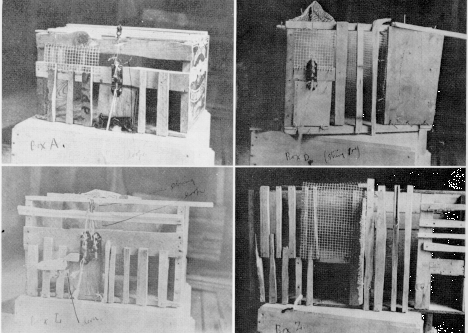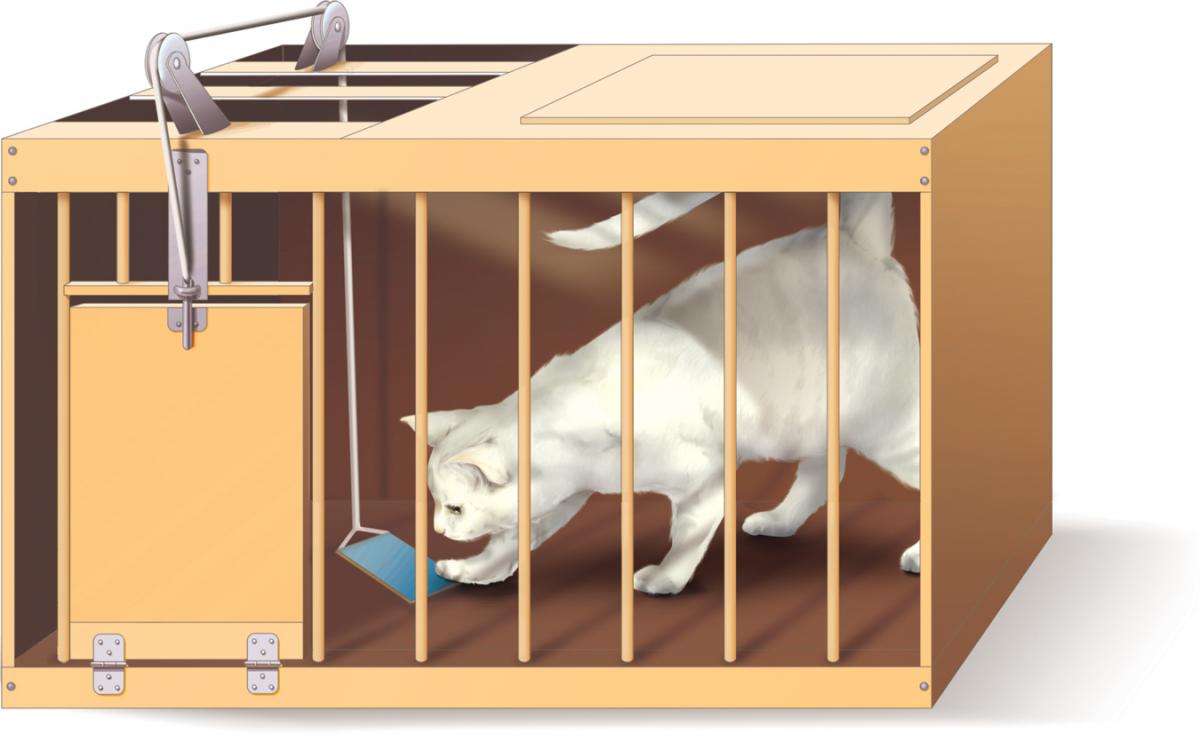The Great Escape of Pigeon 2748
The laboratory study of reinforcement began with Psychologist Edward L. Thorndike’s doctoral dissertation at Columbia University in New York City. Thorndike built a series of wooden “puzzle boxes,” examples of which are shown in the photographs below (the first photo shows the actual boxes Thorndike used and the second a schematic of how they worked).


He then recruited some local cats as participants. Each was placed in one of the boxes and Thorndike measured the amount of time that it took for them to learn to manipulate the complicated locks to open the door and exit the puzzle box. The clincher was that when they escaped from the boxes, food was available as soon as they got out. Each of his cats learned to escape from the boxes and did so with increasing speed over the course of several trials. Dogs, rats, and raccoons also were shown by Thorndike and other psychologists (one was John B. Watson) to learn an escape response from a puzzle box.
In our laboratory at West Virginia University, we often house pigeons in a holding cage to await their turn to be placed in an operant conditioning chamber for their daily testing session involving some behavioral task. The pigeon is placed inside the cage, the wire-barred door is closed and latched, and we go about our work until the pigeon is needed in the chamber. Over the past few months, when we have left one particular pigeon (number 2748) in the holding cage, we typically have found him awaiting us in some pigeon-friendly spot in the lab – far from the cage in which he was placed. We previously had seen Pigeon 2748 pecking at the latch on the cage, but had never “caught him in the act” of opening the cage.
We set up a video camera, left him alone, and you can access the result here. There are two clips, the first is about 3 minutes long and the second about 5 minutes. The first was taken in April of this year in an isolated room of the lab shows our fine feathered friend going through a series of approximations to opening the cage door. The second, shot in early July of this year in the same room, shows a smoother opening of the latch and an actual “escape” from the cage.
Have a look, and keep in mind that there is a big difference between our escaping pigeon and Thorndike’s “puzzle box” investigations. In those, the animals received food on completing the escape response. For our pigeon, the only reinforcer was the escape itself – once out there was no food, just a little extra attention from us as we struggled to catch him and return him to the holding cage. It seems that just manipulating the latch and escaping were sufficient reinforcers to maintain the behavior.

Pigeon 2748 awaits the impending game of “catch the pigeon”
after letting himself out of the holding cage.
This is the only pigeon that we have ever observed to open the latched door and escape from the holding cage, even though this cage has been in use in our lab for at least 30 years. Presumably the response was learned through the usual methods of shaping, except (a) there was no shaper of such behavior except Pigeon 2748 itself, and (b) the only reinforcer was the opportunity to open the cage and exit. Of course, much of human shaping is like this, too, as was discussed in an earlier commentary. Tasks shape through building on responses “already in your repertoire” (just as the pecking response is already in our feathered friend’s repertoire). And rewards often consist of task completion rather than anything tangible or consumable such as food or water.



